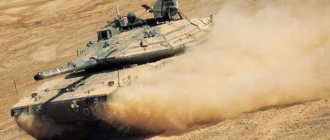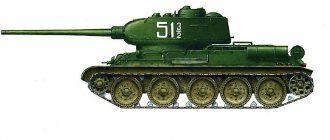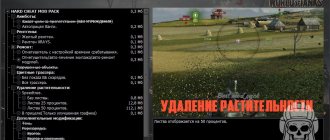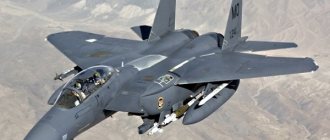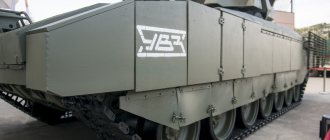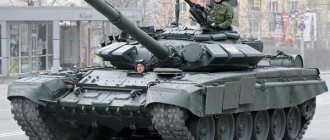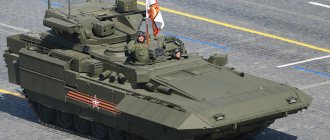Despite its small size, the State of Israel is one of the most significant countries. This is true both on the European-Middle Eastern and global stage. Created in 1948, it was forced from birth to fight for independence and the right to exist. Of course, it is impossible to fight without new and modern weapons.
One of the main developments of the Israeli army, the IDF, is the Merkava tank. Created, in fact, in a hurry, in the conditions of a constantly looming war, this device became one of the best examples of armored vehicles of the 20th century, and continues to hold its position in the 21st.
Creation of the Merkava
Since the creation of the State of Israel, the Self-Defense Forces have purchased equipment abroad, mainly in Britain and the USA. At first these were samples left over from the Second World War. Then the newest models of the Chieftain tanks at that time began to enter service with the IDF. The difficult international situation led to the fact that in 1970 Britain refused to supply Israel with new equipment.
In principle, the Israeli generals were ready for such a development of events. The extensive work to create his own model of the tank was led by Israel Tal.
At the time of the events described, “Talik” served in the Jewish Legion of the British Army during the Second World War, and also participated in the Six-Day War. A brilliant theorist, it was he who created the tactics and strategy for using the IDF’s armored forces, and also coordinated the creation of the “ideal” tank for operations in the climate of Palestine.
The project was called “Merkava”, which translates as “chariot”. It is important to know that the name has a religious background. In sacred Jewish texts, Merkabah is the chariot of God, the throne on which the Almighty moves in the book of the prophet Ezekiel. A pretentious name for a tank, into the design of which one of the best tankers in history put his heart and soul into its design.
When designing the model, Tal was based on the general strategy of the Israeli Defense Forces.
It implied the awareness of the enemy’s total superiority in manpower and equipment, the impossibility of strategic or tactical retreat, as well as waging a war of attrition. All the peculiarities of the climate of Palestine and the Middle East, where the tanks had to prove themselves, were also taken into account.
The vehicle had to meet several combat parameters. First, and most importantly, the new tank had to have a lowered silhouette and a small turret. An analysis of the combat operations showed that most of the hits fell on the turret. Penetrating the armor meant, in most cases, death or serious injury to the crew.
Neither Tal nor anyone else wanted to risk tankers, so they took the requirements into account. Another important point is long-range shooting. The Israelis had to knock out enemy tanks as early as possible, on the approach to defensive positions. Hence special attention to the gun and to the training of the gunner.
December 1974 was marked by the first serious army tests of prototypes. In 1979, the IDF received the first batch of production tanks put into service.
Mark 3
| System/subject | Mark 3 |
| Main gun (caliber) | 120 mm |
| Engine | 1,200 hp |
| Transmission | Automatic, 4 gears |
| Running gear | External, single, position, rotary shock absorbers |
| Weight | 65 |
| Turrent control | Electrical |
| Fire control | Advanced computer Line of sight stab in two areas TV & thermal auto-tracker Modern laser range finder Thermal night-vision TV channel Dynamic cant angle indicator Commander's sights |
| Heavy ammunition storage | Protected container for every four rounds |
| Ready to fire ammunition storage | Mechanical drum case for five rounds |
| 60 mm mortar | Internal |
| Electromagnetic warning | Advanced |
| NBC protection | Combined overpressure and air cond (in Baz tanks) |
| Ballistic protection | Modular special armor |
Design of the Merkava
The peculiarities of both the climate and the small size of Israel made it possible to create a tank that was unique in its characteristics. The main difference was the location of the engine and transmission in the bow.
This unusual layout for a tank made it possible to protect the crew and provide free space in the stern.
It could be used to safely transport infantry or cargo. But this arrangement also has disadvantages. Among them, the most notable are the overweight and significant fluctuations due to a shift in the center of gravity, as well as hot rising air currents from the engine, knocking down the sighting devices.
The crew consists of four people. The driver is located in the body. Its seat is made in a reclining position, a revolutionary solution, one of the first to reduce the silhouette of the car.
There are also disadvantages: the location of the transmission and engine moved the driver far to the left, reducing the viewing sector. The fighter gets to his place either through the top hatch in the armored hull, or together with the rest of the crew through the stern and warhead. The three remaining tankers are sitting in the combat unit, the gunner is to the right of the gun, the commander is behind him, and the loader is to the left. All crew members are located as low as possible in the hull, so that in the event of a hit and penetration of the armor there is a greater chance of survival.
The tank's turret is wedge-shaped to increase the likelihood of a ricochet from an enemy shot. It is equipped with a movable gun (which differs depending on the modification of the tank), as well as a heavy machine gun and a pair of standard single machine guns (the installation diagram depends on the modification). The tower, as well as the hull, is of a welded type.
One of the hallmarks of the tower is suspended metal weights on chains. They are necessary to prevent grenades, cumulative shells and other potentially dangerous objects from getting into the gap between the hull and the turret. Another feature of the tank is its large mass by modern standards. Since transporting tanks is not a particular problem due to the small size of the country, engineers were essentially given carte blanche to make any changes in weight that did not interfere with the power plant.
The machine uses an American-designed diesel engine AVDS-1790-5A, which develops power up to 900 hp due to turbocharging.
The production of power plants is carried out in the United States. The transmission is also American, but adapted to the characteristics of both the climate and the tactics of using armored vehicles.
The chassis is of an independent type, based on the legendary design of John Christie. On each side of the Israeli Merkava tank there are six rubberized rollers and five support rollers. The engineers abandoned the torsion bar suspension, which made it possible to strengthen the underbody armor. A mine explosion is scary for the Merkava crew only because of the need to change the tracks. The tracks themselves have 110 tracks, 640 mm wide.
The armament of the first models was a licensed American 105-mm M68 cannon, coaxial with a machine gun. The combat configuration included 62 shots, high-explosive, armor-piercing, and sub-caliber shells. Later models were equipped with the 120 mm smoothbore gun MG251, and then the more advanced MG253. Additional weapons can be considered not only large-caliber Browning machine guns, but even a 60-mm mortar welded to the turret.
28% of the tank's production is concentrated abroad, including vital engines and some other systems. The rest is produced and repaired in Israel, including imported parts.
Mark 2
| System/subject | Mark 2 |
| Main gun (caliber) | 105 mm |
| Engine | 900 hp |
| Transmission | Automatic, 4 gears |
| Running gear | External, double positions, linear shock absorbers |
| Weight | 63 |
| Turrent control | Hydraulic |
| Fire control | Digital computer Laser rangefinder Thermal night vision |
| Heavy ammunition storage | Protected container for every four rounds |
| Ready to fire ammunition storage | Six rounds magazine |
| 60 mm mortar | Internal |
| Electromagnetic warning | Basic |
| NBC protection | Overpressure |
| Ballistic protection | Laminated armor + special armor |
Tank modifications
Development and improvement of the combat vehicle continues to this day. Each modification has hundreds of small modifications, prompted by daily service and participation in combat operations. Main modifications of the machine:
- Mk.1, the first tank in the series to have many “childhood diseases”, tested during the Lebanon War;
- Mk.2, with enhanced armor protection and power plant;
- Mk.3, which received modular armor;
- Mk.4, the best main tank according to many military agencies, however, has many disadvantages, such as a high hull, problems with aiming and firing on the move. Numerous military clashes forced us to strengthen the vehicle’s protection systems, as well as change the engine brand, which seriously improved driving performance.
Development of a new “tank of the future” is ongoing. Whether this will be another modification of the Merkava or a fundamentally new combat vehicle is unknown.
The Israeli government and military are good at keeping secrets, so practically nothing is known about the Mk.5 yet.
Mark 1
| System/subject | Mark 1 |
| Main gun (caliber) | 105mm |
| Engine | 900 hp |
| Transmission | Semi-automatic |
| Running gear | External, double positions, linear shock absorbers |
| Weight | 63 |
| Turrent control | Hydraulic |
| Fire control | Digital computer Laser rangefinder Thermal/passive night vision |
| Heavy ammunition storage | Protected container for every four rounds |
| Ready to fire ammunition storage | Six round magazine |
| 60 mm mortar | External |
| Electromagnetic warning | Basic |
| NBC protection | Overpressure |
| Ballistic protection | Laminated armor |
Comparison with analogues
As you know, a tank’s characteristics look best when compared with those of a potential enemy. This table provides generalized data on the most common main tanks and their modifications.
| "Merkava" (Israel) | T-90 (Russia) | Abrams (USA) | "Leopard 2" (Germany) | |
| Weight, t | 70 | 46,5 | 54,4…63,1 | 50,5…63 |
| Armor thickness, mm | 800 | 750 | 750-950 | frontal 700 |
| gun | 120 mm MG253 | 125 mm 2A46M-5 | 120 mm M256 | Rheinmetall Rh-120 mm |
| Speed, km/h | 60 | 65-70 | 66-72 | 68-72 |
| Cruising range, km | 500 | 550…650 | 440…480 | 500…550 |
| Number of units, pcs | 1970 | More than 2000 | More than 10000 | 3264 |
As can be seen from the table, Merkava has low driving characteristics, but its strength lies elsewhere.
The location of the power plant seriously increases the armor and safety of the crew in case of being hit by enemy anti-tank missiles. The development of active and dynamic armor systems for tanks is also not taken into account. The moment of combat use of vehicles is also important. The crews of Israeli tanks have a lot of experience, which cannot be said about, for example, German tank crews.
Specifications
| Crew | 4 people |
| Weight with ammunition | 65 tons |
| Tank length | 7 m 45 cm |
| Length with gun | 9 m 40 cm |
| Clearance | 53 cm |
| Width over tracks | 3 m 72 cm |
| Tower hatch height | 2 m 70 cm |
| CHARACTERISTICS IN MOVEMENT CONDITIONS | |
| Engine power, 12-cylinder, four-stroke, water-cooled, turbocharged diesel engine | 1500 l. With. |
| Diesel fuel tank life on the highway; capacity 1400 liters | 500 km |
| Highway speed | 65 km/h |
| Speed on arable land | 50 km/h |
| Obstacle elevation angle | 30 degrees |
| Obstacle barrier | 1m |
| Barrier ditch | 3m |
| Obstacle ford | 1 m 38 cm |
| COMBAT WEAPONS | |
| Gun type; caliber | Smoothbore caliber 120 mm |
| Gun ammunition | 10 shells in the machine gun + 36 shells + 14 emergency |
| FN MAG coaxial machine gun | 7.62 mm |
| Anti-aircraft machine gun | 7.62 mm |
| Mortar | 60 mm |
| PROTECTION AND DEFENSE | |
| Combined cast steel armor, active, dynamic protection. |
Combat service of Merkava tanks
Tal's first-born sons received their baptism of fire in the 1982 Lebanon War. Then, however, the new developments failed to compete with the Soviet T-72, which was in service with the Syrian army. Perhaps this is for the better, since the first cars had a huge number of shortcomings related to the chassis and engines.
Both the armor and firepower raised questions.
This was the reason for the refinement and commissioning of subsequent modifications of the machine. There are many legends about this war, each side talks about hundreds of destroyed enemy tanks, so you simply cannot believe everything.
Since then, tanks have appeared whenever the State of Israel is threatened with war. Tanks were widely used during the Second Lebanese War. Then the Israeli vehicles received significant damage, but Tal’s idea turned out to be correct. The bulk of the crew members survived and were able to continue serving.
The combat effectiveness of the vehicles during clashes with Palestinians is controversial. Officially, losses in this war are reduced to light damage. However, the Palestinians claim that the IDF data is seriously underestimated to create an aura of invincibility of the Merkava.
M1A2 USA
| M1A2 (USA) | |
| Commander's device, type, brand | Panoramic combined sight CITV |
| Line of sight stabilization | two-plane independent |
| Optical channel | Absent |
| Night channel | 2nd generation thermal imager |
| Rangefinder | Laser |
| Gunner's sight, type, brand | Combined, periscopic GPS |
| Line of sight stabilization | independent poVN |
| Day channel | optic |
| Night channel | 2nd generation thermal imager |
| Rangefinder | laser |
| Weapon stabilizer, type, brand | two-plane, electromechanical |
| Guided missile information channel | absent |
Leclerc
| Leclerc (France) | |
| Commander's device, type, brand | Panoramic combined sight NL-70 |
| Line of sight stabilization | two-plane independent |
| Optical channel | Eat |
| Night channel | 2nd generation thermal imager |
| Rangefinder | Laser |
| Gunner's sight, type, brand | Combined, periscopic HL-60 |
| Line of sight stabilization | two-plane independent |
| Day channel | optical and television |
| Night channel | 2nd generation thermal imager |
| Rangefinder | laser |
| Weapon stabilizer, type, brand | two-plane, electromechanical |
| Guided missile information channel | absent |
Leclerc
| Leclerc (France) | |
| Gun index | CN-120-26 |
| Caliber, mm | 120 |
| Barrel type | smoothbore |
| Barrel tube length, mm (calibers) | 6200 (52) |
| Gun weight, kg | 2740 |
| Rollback length, mm | 440 |
| Type of bore purging | ventilation |
| Barrel survivability, rds. BPS | 400 |
Leopard
| "Leopard-2A5 (6)" (Germany) | |
| Commander's device, type, brand | Panoramic combined sight PERI-R17AL |
| Line of sight stabilization | two-plane independent |
| Optical channel | Eat |
| Night channel | 2nd generation thermal imager |
| Rangefinder | Laser |
| Gunner's sight, type, brand | Combined, periscopic EMES-15 |
| Line of sight stabilization | two-plane independent |
| Day channel | optic |
| Night channel | 2nd generation thermal imager |
| Rangefinder | laser |
| Weapon stabilizer, type, brand | two-plane, electromechanical |
| Guided missile information channel | absent |
Leopard
| "Leopard 2A5(6)" (Germany) | |
| Gun index | Rh44 |
| Caliber, mm | 120 |
| Barrel type | smoothbore |
| Barrel tube length, mm (calibers) | 5300 (44) |
| Gun weight, kg | 3130 |
| Rollback length, mm | 340 |
| Type of bore purging | ejection |
| Barrel survivability, rds. BPS | 700 |
Modernization
- "Merkava Mk.1B", 1983 - partially modernized to the level of Mk.2, previously built Mk.1. The side screens were replaced, an anti-cumulative screen was installed, and the fire control system was improved to the level of Mk.2 or Mk.2B. But, despite these advantages, the turret is devoid of additional equipment, there are no baskets for property on the rear part, and a 60-mm mortar is still located in the external position.
- "Merkava Mk.2D", 1999 - modernized, previously built "Merkava Mk.2B". The turret and hull were treated with fourth generation armor
- Also, the bulk of the tanks in reserve received additional armor for the turret roof. And tanks with this capability were equipped with a “Baz” sight.
M1A2
| M1A2 (USA) | |
| Gun index | M256 |
| Caliber, mm | 120 |
| Barrel type | smoothbore |
| Barrel tube length, mm (calibers) | 5300 (44) |
| Gun weight, kg | 3065 |
| Rollback length, mm | 305 |
| Type of bore purging | ejection |
| Barrel survivability, rds. BPS | 700 |
